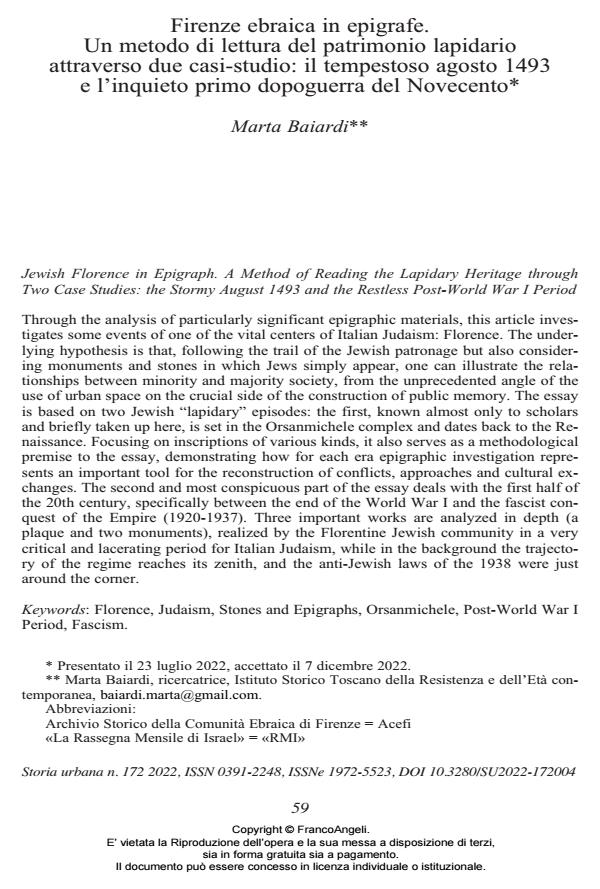Jewish Florence in Epigraph. A Method of Reading the Lapidary Heritage through Two Case Studies: the Stormy August 1493 and the Restless Post-World War I Period
Journal title STORIA URBANA
Author/s Marta Baiardi
Publishing Year 2023 Issue 2022/172
Language Italian Pages 27 P. 59-85 File size 391 KB
DOI 10.3280/SU2022-172004
DOI is like a bar code for intellectual property: to have more infomation
click here
Below, you can see the article first page
If you want to buy this article in PDF format, you can do it, following the instructions to buy download credits

FrancoAngeli is member of Publishers International Linking Association, Inc (PILA), a not-for-profit association which run the CrossRef service enabling links to and from online scholarly content.
Through the analysis of particularly significant epigraphic materials, this article inves- tigates some events of one of the vital centers of Italian Judaism: Florence. The under- lying hypothesis is that, following the trail of the Jewish patronage but also consider- ing monuments and stones in which Jews simply appear, one can illustrate the rela- tionships between minority and majority society, from the unprecedented angle of the use of urban space on the crucial side of the construction of public memory. The essay is based on two Jewish “lapidary” episodes: the first, known almost only to scholars and briefly taken up here, is set in the Orsanmichele complex and dates back to the Re- naissance. Focusing on inscriptions of various kinds, it also serves as a methodological premise to the essay, demonstrating how for each era epigraphic investigation repre- sents an important tool for the reconstruction of conflicts, approaches and cultural ex- changes. The second and most conspicuous part of the essay deals with the first half of the 20th century, specifically between the end of the World War I and the fascist con- quest of the Empire (1920-1937). Three important works are analyzed in depth (a plaque and two monuments), realized by the Florentine Jewish community in a very critical and lacerating period for Italian Judaism, while in the background the trajecto- ry of the regime reaches its zenith, and the anti-Jewish laws of the 1938 were just around the corner.
Keywords: Florence, Judaism, Stones and Epigraphs, Orsanmichele, Post-World War I Period, Fascism.
Marta Baiardi, Firenze ebraica in epigrafe. Un metodo di lettura del patrimonio lapidario attraverso due casi-studio: il tempestoso agosto 1493 e l’inquieto primo dopoguerra del Novecento in "STORIA URBANA " 172/2022, pp 59-85, DOI: 10.3280/SU2022-172004